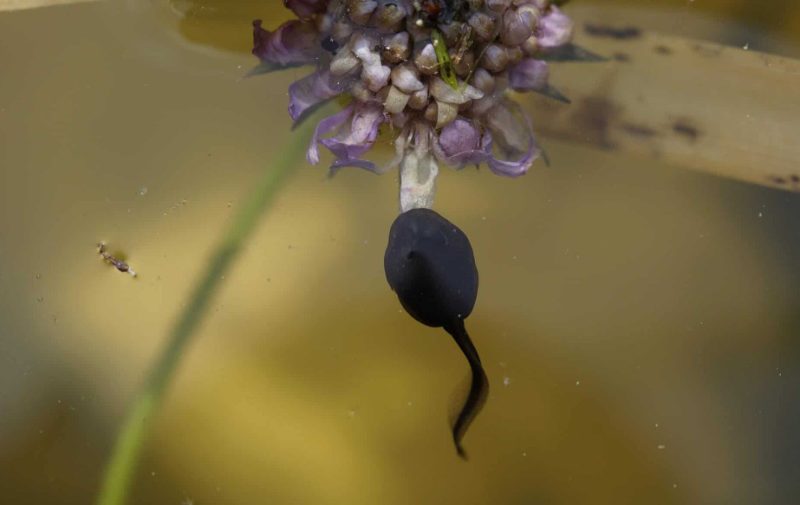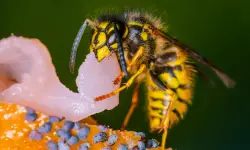Tadpoles are fascinating creatures — the early life stage of frogs that thrive in water before transforming into amphibious adults. Watching them grow and change is one of nature’s most remarkable processes. But understanding what tadpoles eat during each stage of their growth is key to keeping them healthy and active.
Unlike adult frogs, which are carnivorous, tadpoles start life as mostly herbivores, feeding on soft plant matter and algae. As they grow, their diet gradually shifts toward protein-rich foods, preparing their bodies for metamorphosis.
Whether you’re observing tadpoles in the wild or caring for them in a tank, knowing their favorite foods helps ensure proper growth, energy, and survival through every stage of development.
Understanding the Tadpole Diet

How Tadpoles Feed
Tadpoles are equipped with tiny, rasping mouthparts designed for scraping and sucking. In the early stages, they use these structures to graze on algae, biofilm, and soft decaying plant material found in ponds or streams. Their feeding habits change as they grow — young tadpoles are strict vegetarians, but older ones begin incorporating small insects and animal proteins into their diet.
They feed throughout the day, consuming whatever organic matter they can find. Because their digestive systems are designed for high metabolism, they need a constant supply of food to fuel their rapid growth and tail development.
Nutritional Needs
A healthy tadpole diet includes a balance of plant-based fiber, natural proteins, and minerals. In the early days, leafy greens and algae provide essential carbohydrates and calcium for bone and tail structure. Later, protein from insects or egg matter supports leg and organ formation as metamorphosis begins.
Tadpoles are also sensitive to water quality. Clean, oxygen-rich water ensures they can process food efficiently. Poor conditions slow growth and can even prevent transformation into frogs.
Natural Feeding Behavior
In the wild, tadpoles act as both grazers and scavengers. They clean ponds by consuming decaying matter, algae, and microorganisms. This not only nourishes them but also maintains a balanced ecosystem. Their feeding habits naturally shift with water temperature, available food, and developmental stage.
Understanding this transition — from herbivore to omnivore — is crucial for anyone keeping tadpoles, as it determines both their diet and survival success.
20 Foods Tadpoles Love the Most
1. Algae
Algae form the foundation of a tadpole’s early diet. These microscopic plants grow naturally on rocks, leaves, and pond surfaces, providing soft, easy-to-digest nutrients.
Young tadpoles graze on algae using their rasping mouths, scraping it from submerged surfaces. Algae are rich in chlorophyll and fiber, which aid digestion and energy.
In captivity, you can grow natural algae in tanks by allowing some sunlight and avoiding over-cleaning the glass — tadpoles thrive when they can graze freely.
2. Aquatic Plants
Soft aquatic plants like duckweed, hornwort, and anacharis are ideal for tadpoles. These plants provide fiber, hydration, and a natural grazing surface that mimics their wild habitat.
Tadpoles often nibble on the edges of leaves or feed on decaying fragments that break off. This helps them obtain essential nutrients without straining their delicate digestive systems.
Keeping a few live plants in a tank not only offers food but also maintains better water quality and oxygen levels.
3. Decaying Plant Matter
Decomposing leaves and stems are another natural food for tadpoles. In ponds, they consume this organic debris as it breaks down, gaining nutrients from both the plants and the bacteria involved in decomposition.
This type of food is soft and rich in minerals, ideal for very young tadpoles still developing mouthparts. It’s also a sustainable food source that constantly replenishes in nature.
For home habitats, adding a few boiled, pesticide-free leaves can replicate this natural food source.
4. Biofilm
Biofilm is a slimy layer of microorganisms and organic material that coats rocks and plants in water. It’s packed with microscopic algae and bacteria — perfect nutrition for newborn tadpoles.
They graze on this film throughout the day, helping clean surfaces while feeding themselves.
Biofilm naturally develops in ponds and tanks, so maintaining some rough surfaces encourages healthy tadpole foraging behavior.
5. Boiled Lettuce
In captivity, boiled lettuce is one of the best plant-based foods for tadpoles. Softened leaves are easy to eat and full of fiber, iron, and vitamins.
The gentle boiling process breaks down cellulose, making nutrients more accessible for digestion. Tadpoles readily consume small bits floating on the water surface.
Just ensure the lettuce is unsalted and unseasoned, as any chemicals or oils can harm them.
6. Spinach
Spinach provides a natural source of iron, calcium, and antioxidants essential for tadpole growth. When lightly blanched, it becomes tender enough for easy nibbling.
This leafy green supports bone and muscle development as tadpoles prepare for metamorphosis. It’s also a great substitute for algae when natural growth is limited.
Offering spinach once or twice a week keeps captive tadpoles healthy and vibrant.
7. Zucchini
Zucchini is a favorite soft vegetable for older tadpoles. Its high moisture and mild flavor make it easy to digest.
Sliced, boiled pieces can be placed in the tank, where tadpoles nibble on them throughout the day. It mimics their natural habit of grazing on decaying vegetation.
Zucchini also provides fiber and trace minerals, which promote healthy digestion and steady growth.
8. Peas
Shelled and boiled peas are a great source of plant protein and carbohydrates. They help older tadpoles build strength and prepare for their transition into frogs.
Peas also prevent digestive issues, acting as a mild cleanser for the gut. Their soft texture makes them perfect for mid-stage tadpoles that have begun eating more substantial food.
Crush the peas before feeding to make them easier to consume.
9. Boiled Carrots
Boiled carrots are another gentle vegetable option rich in vitamin A and beta-carotene. These nutrients help support early vision and cell development in growing tadpoles.
Softened carrots can be sliced into thin strips or mashed into small pieces. Tadpoles will graze on them over several hours.
They also add variety to the diet, encouraging balanced nutrition and natural feeding behavior.
10. Fish Food Flakes
In controlled environments, high-quality fish flakes provide an excellent protein and vitamin source. They’re especially useful for older tadpoles that are transitioning into omnivorous diets.
The flakes dissolve slowly, allowing easy grazing without polluting the water. Choose options with spirulina or algae-based ingredients to mimic their natural foods.
This supplement ensures consistent nutrition even when plant matter is limited.
11. Boiled Broccoli
Broccoli, when lightly boiled, provides calcium, fiber, and vitamin K — vital nutrients for skeletal development. Its florets soften easily, making them suitable for tadpoles to chew.
Small pieces can be floated in the tank or attached to a rock for natural grazing.
Avoid overfeeding, as too much broccoli can cloud the water or decay quickly.
12. Bloodworms
As tadpoles mature, they begin craving more protein. Bloodworms are one of the best animal-based foods at this stage.
They provide high protein, iron, and amino acids that help with tissue growth and leg formation. Frozen or freeze-dried varieties are safer and easier to manage than live ones.
Feed sparingly — too much protein early can cause bloating or water quality issues.
13. Brine Shrimp
Brine shrimp are small, soft, and highly nutritious for older tadpoles nearing metamorphosis. They deliver healthy fats and proteins essential for developing lungs and limbs.
Tadpoles readily chase and consume live shrimp, promoting natural hunting behavior.
Feeding a small amount every few days adds excitement and variety to their diet.
14. Egg Yolk
Boiled egg yolk is a traditional, nutrient-rich food for tadpoles. It provides protein, fats, and vitamins crucial during rapid growth stages.
Mash a small portion and mix it in water so tadpoles can feed without choking. It’s especially helpful for tadpoles raised indoors without access to live food.
Use sparingly to prevent clouding or bacterial buildup in the tank.
15. Algae Wafers
Algae wafers, commonly sold for aquarium fish, are perfect for tadpoles. They offer concentrated plant nutrition and remain intact underwater for hours.
Tadpoles can nibble at them slowly, mimicking their natural grazing habits.
Choose wafers made with spirulina and avoid those containing artificial additives.
16. Frog or Reptile Pellets
Specially formulated frog or reptile pellets can provide a complete nutrient balance for captive tadpoles. They’re rich in protein, calcium, and vitamins needed for metamorphosis.
The pellets soften in water, making them easy for tadpoles to consume.
Use only small quantities and remove leftovers to keep the habitat clean.
17. Insect Larvae
Older tadpoles occasionally feed on small insect larvae like mosquito wrigglers. This shift toward carnivory helps prepare them for their adult frog diet.
Insect larvae supply protein and minerals that enhance development.
They’re best suited for wild or outdoor-raised tadpoles that naturally encounter small aquatic insects.
18. Dead Insects
Decomposing insects in ponds serve as a natural protein source. Tadpoles nibble on soft parts, gaining essential amino acids.
This scavenging behavior is common in nutrient-rich waters where plant food may be limited.
In captivity, tiny dried insects or crushed mealworms can serve as substitutes in moderation.
19. Microorganisms
Tadpoles constantly consume microorganisms found in pond water — including plankton, bacteria, and protozoa. These microscopic foods provide vital nutrients during early development.
They graze naturally on surfaces coated with microbial growth, strengthening their immune systems and gut flora.
For tank setups, adding pond water or using natural rocks encourages healthy microorganism growth.
20. Leaf Debris and Mulch
Floating leaf litter and decomposing organic mulch are common food sources in natural ponds. Tadpoles feed on both the decaying matter and microorganisms that thrive within it.
This organic food keeps ecosystems balanced while supporting slow, steady tadpole growth.
In captivity, adding clean, boiled leaves like oak or spinach can mimic this vital natural element safely.
FAQs About What Tadpoles Eat
Do Tadpoles Eat Algae Only?
No. While young tadpoles start with algae and plants, they later include proteins like insects or eggs as they grow.
Can You Feed Tadpoles Lettuce?
Yes, boiled lettuce is one of the best captive foods — soft, safe, and nutritious.
How Often Should Tadpoles Be Fed?
Feed them small portions two to three times daily. Avoid overfeeding to keep water clean.
Do Tadpoles Eat Each Other?
In rare cases, when food is scarce, older tadpoles may nibble on smaller ones for protein.
Can Tadpoles Eat Fish Food?
Yes, algae-based fish flakes or pellets are excellent supplemental foods for captive tadpoles.
What Do Tadpoles Eat in the Wild?
They eat algae, decaying leaves, microorganisms, and occasionally small aquatic insects.
When Do Tadpoles Start Eating Meat?
Around the time they begin growing legs, usually three to five weeks after hatching.
Can Tadpoles Eat Fruits or Vegetables?
Yes, soft vegetables like zucchini or boiled spinach are safe and nutritious options.
Do Tadpoles Need Clean Water to Eat?
Absolutely. Clean, oxygenated water ensures they digest food properly and stay healthy.
Final Thoughts
Tadpoles may start life as simple algae grazers, but their diet quickly evolves as they grow. From leafy greens to tiny insects, every food they eat helps fuel one of nature’s most magical transformations — from aquatic larvae to land-dwelling frogs.
Understanding what tadpoles eat not only helps in raising them successfully but also highlights their ecological role in keeping freshwater ecosystems balanced. When we protect their habitats and ensure clean water, we support the next generation of frogs — vital contributors to our planet’s biodiversity.






